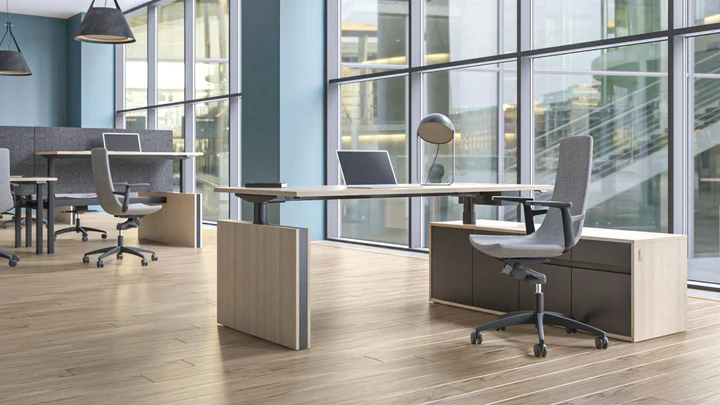
In a world where technology has transformed work culture and the majority of our daily tasks revolve around sitting in front of screens, ergonomics has emerged as an essential facet of a modern workspace. Ergonomics is the scientific discipline concerned with understanding the interactions among humans and other elements of a system. It’s a field that applies theory, principles, data, and methods to optimize human well-being and overall system performance.
The importance of ergonomics in the workplace setup cannot be overstated. An ergonomically designed workspace can help maximize productivity by reducing employee discomfort and the potential for injuries associated with poor posture and repetitive tasks. It also enhances overall employee well-being, contributing to a healthier and more positive work environment. At the center of any ergonomically optimized workspace is the humble yet vital component – the chair. And not just any chair, but an ergonomic chair. Our thesis focuses on the significant role ergonomic chairs play in enhancing both comfort and productivity. Think of it as a faithful sidekick, always there, supporting you, literally, and helping you perform your best by ensuring your physical well-being.
This guide aims to provide insights into the world of ergonomic chairs and their undeniable contribution to a comfortable, healthy, and productive working lifestyle. Let’s delve into this hidden cornerstone of workplace success and learn how it can transform your working experience. Buckle up, as we venture into the world of ergonomic chairs, where comfort marries productivity!
Understanding Ergonomic Chairs and Their Special Features
As we embark on this journey to explore the fascinating world of ergonomic chairs, let’s start by understanding what these chairs are. An ergonomic chair is a seat specifically designed to provide the utmost comfort while reducing stress and eliminating injuries related to prolonged sitting. It supports the natural alignment of the body, preventing musculoskeletal disorders that could hinder productivity.
Diving deeper, let’s familiarize ourselves with the key features that define ergonomic chairs:
- Adjustable height: The adjustable height feature ensures that the chair can accommodate users of different heights. It allows individuals to adjust the chair so that their feet are flat on the floor, and their knees are at a 90-degree angle, parallel to the hips. This setup helps to promote blood circulation and reduce pressure on the lower back.
- Lumbar support: The human spine has a natural curve, and sitting for long periods without proper support can lead to slouching and strain of the lower spine. Ergonomic chairs have a lumbar adjustment so that users can get the right fit to support the inward curve of the lower back, preventing potential spinal issues.
- Adjustable armrests: Armrests should provide comfortable support to your arms while allowing your shoulders to relax. They should be adjustable in height and width so that users can find the perfect spot to support their arms while typing or doing other desk-related work.
- Seat depth and width: The seat should have enough depth and width to support any user comfortably. A good seat depth is one that allows the user to have their back against the backrest while leaving approximately 2 to 4 inches between the back of the knees and the seat of the chair.
- Backrest: The backrest of an ergonomic chair should be adjustable in angle and height. It should be able to support the natural curve of the spine, offering support in the areas you need it most.
- Swivel and mobility: An ergonomic chair should easily rotate so the user can reach different areas of their workspace without strain. Casters or wheels offer mobility, enabling users to move around their workspace without having to stand.
Behind every great ergonomic chair is a wealth of scientific research. The design of these chairs is not arbitrary but informed by a detailed understanding of human anatomy, biomechanics, and ergonomics. They are made to align with the body’s natural posture, distribute weight evenly, and minimize strain on the body’s musculoskeletal system. The goal is to keep the body in neutral alignment, where all body parts are balanced and supported, reducing the likelihood of discomfort and injury. So, behind their sleek and modern aesthetic, ergonomic chairs carry a profound scientific basis aiming to make our sitting hours healthier and more productive.
The Impact of Ergonomic Chairs on Health
Ergonomic chairs greatly contribute to preventing musculoskeletal disorders, promoting proper posture, and reducing work-related injuries. By providing targeted support to the spine and neck, they mitigate the risk of chronic pain and serious health issues. They also encourage movement and switching postures, improving circulation and reducing the likelihood of repetitive strain injury. Ultimately, ergonomic chairs, by enhancing comfort and physical well-being, also contribute to better mental health and a positive work environment.





More Stories
Buy Instagram Followers and Likes: A Detailed Review of InsFollowPro.com
Things to Consider When Going with Sliding Patio for Backyard
Where to Start Automation. Monitor Stands